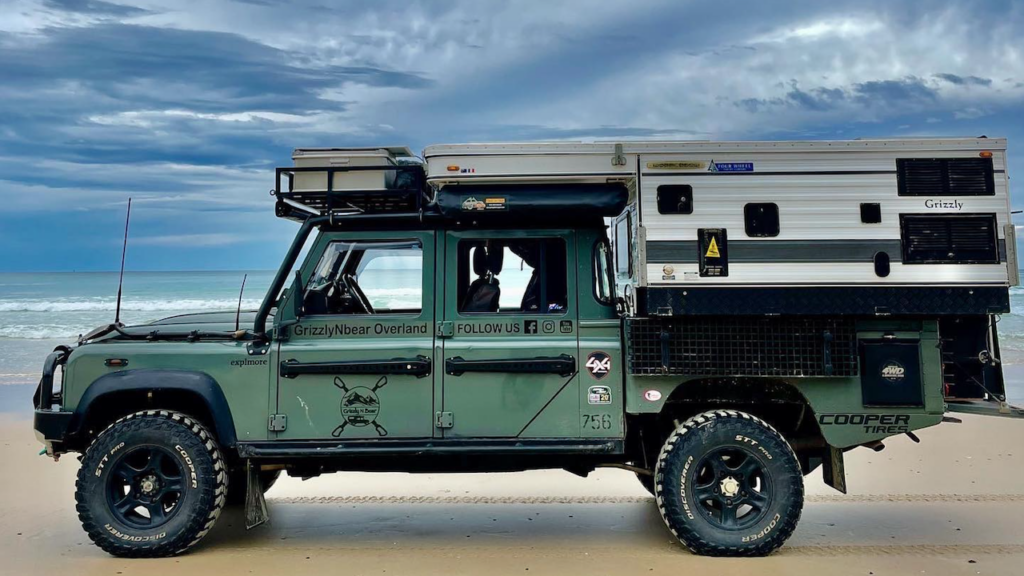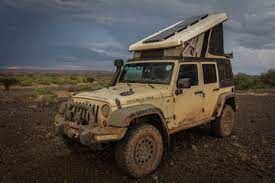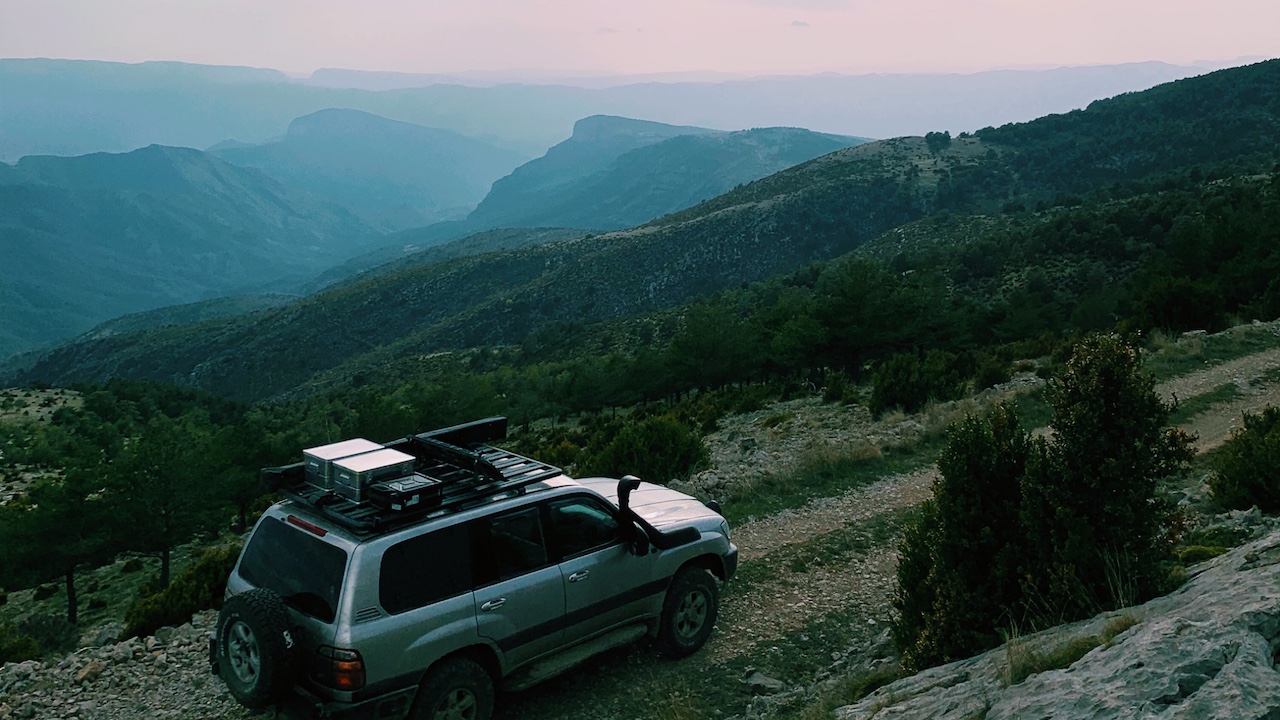Overlanding is the ultimate way to explore the great outdoors if you’re looking for adventure. However, selecting the right vehicle is critical for a successful journey. In this guide, we’ll look at the best vehicles for overlanding, such as the Toyota Land Cruiser, Jeep Wrangler, Ford F-150, and others. We have you covered whether you’re planning a weekend trip or a month-long expedition. So fasten your seatbelts and get ready to go!
Toyota Land Cruiser
Toyota Land Cruiser is a legendary vehicle that has been in production for more than 60 years. Originally designed as a military vehicle, it has since become a global overlanding staple. The Land Cruiser is well-known for its toughness, dependability, and off-road capabilities, making it an excellent choice for those looking to explore remote areas.
The durability of the Land Cruiser is one of the key features that make it an excellent overlanding vehicle. With a solid body-on-frame construction and a robust suspension system capable of handling even the most difficult terrain, the Land Cruiser is built to last. It also has a high ground clearance, making it simple to maneuver around rocks, logs, and other obstacles.
The versatility of the Land Cruiser is another feature that makes it an excellent overlanding vehicle. It can be configured to meet a variety of requirements, ranging from a family SUV to a fully equipped expedition vehicle. It has a lot of cargo space for supplies and gear, and it can even be outfitted with a rooftop tent for sleeping.
The Land Cruiser is unrivaled in terms of off-road capability. It has full-time four-wheel drive, locking differentials, and a low-range transfer case, allowing it to handle even the most difficult terrain. It also has a number of advanced features, such as crawl control and hill descent control, that make navigating tricky situations even easier.
Overall, the Toyota Land Cruiser is an excellent choice for those looking for a rugged, dependable vehicle that can handle any terrain. Because of its long history and reputation in the overlanding community, it is our top choice for the best vehicles for overlanding.
Read more about one specific Land Cruiser and its Pros and Cons here
Toyota Hilux
Another popular vehicle in the overlanding world is the Toyota Hilux. It has a reputation for dependability and durability, making it a favorite among adventurers worldwide.
The Hilux’s popularity is one of its primary advantages for overlanding. It is widely used by overlanders and has a large following, so parts and accessories are readily available. Additionally, for those who want to modify or customize their vehicle, there is a wealth of information and resources available online.
Another advantage of the Hilux is its ease of use. It is a straightforward, no-frills vehicle that is simple to maintain and repair, even in remote locations. This makes it an excellent choice for those looking to get off the beaten track and explore remote areas.
However, there are some drawbacks to the Hilux. One of the main disadvantages is its size. It is smaller than many other overland vehicles, so it has less room for gear and supplies. It also has less ground clearance than some other vehicles, making it more difficult to navigate over rough terrain.
Despite these flaws, the Toyota Hilux is still a popular choice among overlanders. Its reputation for dependability and durability, as well as its ease of use and popularity, make it an excellent choice for those looking for a capable and dependable vehicle for their off-road adventures.
Land Rover Defender


📍France – Next : ZA
🌏 Full time Overlanders 🌍
Since 2017 36 countries in our own vehicle
Land Rover Defender 130
In the world of off-roading, the Land Rover Defender has a long and illustrious history. Originally intended as a tough utility vehicle, it has come to represent adventure and exploration. Its toughness and dependability have made it a favorite among overlanders for decades.
One of the features that distinguishes the Defender as an excellent overland vehicle is its unrivaled versatility. It can be configured in a variety of ways to suit the needs of any overlander. Further it has a lot of cargo space for supplies and gear, and it can even be outfitted with a rooftop tent for sleeping. On top it also has advanced features such as a snorkel, winch, and locking differentials, which allow it to handle even the most difficult terrain.
The Defender’s classic design is another feature that distinguishes it from other off-road vehicles. The Defender has a timeless, recognizable design that has made it an icon of adventure and exploration. Its rugged, no-frills design is reminiscent of a bygone era, and it has an irresistible charm.
Despite its reputation for toughness, the Defender has some shortcomings as an off-road vehicle. It can be costly to maintain and repair, and parts can be difficult to find in some areas. It also has a low fuel efficiency, which can be an issue for overlanders traveling long distances.
Overall, the Land Rover Defender is an excellent choice for overlanders looking for a tough, versatile, and stylish vehicle. Its reputation in the overlanding community is well-deserved, and its distinct features make it an excellent choice for those looking to explore remote areas in comfort.
Nissan Patrol
The Nissan Patrol is an underappreciated vehicle in the world of overlanding, despite its many advantages for off-road adventures. It has a reputation for reliability and durability, and has proven itself capable of handling even the toughest terrain.
One of the key advantages of the Patrol for overlanding is its size. It is a large vehicle, which means that it has plenty of space for gear and supplies. It also has a high ground clearance and advanced off-road features, such as a locking differential and hill descent control, which make it capable of handling even the most challenging terrain.
Another advantage of the Patrol is its affordability. It is often less expensive than other overlanding vehicles, which can make it an attractive option for those on a budget. Additionally, parts and accessories for the Patrol are relatively easy to come by, which makes it easier to modify and customize the vehicle to suit individual needs.
However, there are also some disadvantages to the Patrol as an overlanding vehicle. One of the main drawbacks is its fuel efficiency. It is a large, heavy vehicle, which means that it can be expensive to operate over long distances. It also has a somewhat dated design, which may not appeal to those who want a more modern-looking vehicle.
Despite these drawbacks, the Nissan Patrol remains a solid choice for overlanders who want a capable and dependable vehicle for their adventures. Its reputation for reliability and durability, combined with its size and affordability, make it a great choice for those who want a vehicle that can handle anything that the road throws at it.
Jeep Wrangler

The Jeep Wrangler is one of the most popular vehicles in the overlanding community, and for good reason. It is a highly capable off-road vehicle that is designed to handle even the toughest terrain, and has a long history of being used for overlanding adventures.
One of the key advantages of the Wrangler as part of the best vehicles for overlanding is its ruggedness. It is built to withstand the rigors of off-road driving, and has a high ground clearance, four-wheel drive, and a range of off-road features that make it well-suited for overlanding adventures.
The Wrangler is also highly customizable, which makes it a popular choice among overlanders who want to tailor their vehicle to their specific needs. There is a wide range of aftermarket parts and accessories available for the Wrangler, which makes it easy to modify and upgrade the vehicle to suit individual preferences.
However, there are also some disadvantages to the Wrangler as an overlanding vehicle. One of the main drawbacks is its lack of cargo space. It is a relatively small vehicle, which means that it may not have enough room for all the gear and supplies that an overlander may need. Additionally, the Wrangler can be expensive to operate over long distances due to its fuel inefficiency.
Despite these drawbacks, the Jeep Wrangler remains a popular choice among overlanders who want a vehicle that is capable of handling even the toughest terrain. Its ruggedness, customizability, and reputation for being a reliable off-road vehicle make it a great choice for those who want to explore the great outdoors.
Ford F-150
When it comes to overlanding vehicles, trucks may not be the first type of vehicle that comes to mind. However, the Ford F-150 is one truck that has surprised many overlanders with its capabilities.
One of the key advantages of the F-150 for overlanding is its versatility. It can handle a wide range of terrain, from rocky trails to sandy deserts, and has a towing capacity that makes it easy to haul all the necessary gear and supplies.
The F-150 also has a number of features that make it a great overlanding vehicle. For example, its high ground clearance and four-wheel drive make it well-suited for off-road driving, while its spacious cabin and large bed provide plenty of cargo space for gear and supplies.
In addition to its off-road capabilities and cargo space, the F-150 also has a range of technology features that can be helpful for overlanders. These include features like blind spot monitoring, lane departure warning, and adaptive cruise control, which can help make long distance driving safer and more comfortable.
While the F-150 may not be the most traditional overlanding vehicle, its surprising capabilities and range of features make it a great choice for those who want to hit the trails in a reliable and versatile truck. Still its our least favorite on the list of the best vehicles for overlanding due to a lacking international support structure and its spare-parts availability.
Mercedes Sprinter
In recent years, the Mercedes-Benz Sprinter has become an increasingly popular choice for overlanders. This is due in large part to its size, versatility, and customization options.
One of the key advantages of the Sprinter for overlanding is its large size. This allows for a lot of customization options, and many overlanders choose to convert the Sprinter into a fully-equipped camper van. With a wide range of features, including a kitchenette, a bed, and a bathroom, the Sprinter can be a home away from home on the road.
Another advantage of the Sprinter is its powerful engine and excellent fuel efficiency. This makes it a great choice for long-distance overlanding trips, where fuel economy is important. The Sprinter also has good off-road capabilities, thanks to its four-wheel drive and high ground clearance.
One of the disadvantages of the Sprinter for overlanding is its cost. The Sprinter is more expensive than many other overlanding vehicles, and the cost of customization can quickly add up. It also requires more maintenance than some other vehicles, which can be a consideration for those planning long-term overlanding trips.
Overall, the Sprinter’s size, versatility, and customization options make it a popular choice for overlanders who are looking for a comfortable and customizable home on the road. However, its cost and maintenance requirements may be a drawback for some overlanders.
Volkswagen Transporter
The Volkswagen Transporter, also known as the VW Bus or Kombi, is a classic overlanding vehicle that has been used for adventure travel around the world for decades. Its distinctive design, spacious interior, and reliable performance have made it a favorite of overlanders and van life enthusiasts.
One of the key features that makes the Transporter a great overlanding vehicle is its spacious interior. The van is available in several different sizes, from the compact T4 to the larger T6, and can be customized with a range of amenities to make it a comfortable home on the road. This includes features like a kitchenette, a bed, and a pop-up roof for extra headroom.
Another advantage of the Transporter is its reliability. The van is known for its durability and can handle rough terrain and challenging weather conditions with ease. It also has good fuel efficiency, which makes it a great choice for long-distance overlanding trips.
One potential disadvantage of the Transporter is its lack of four-wheel drive. While some models do have four-wheel drive, it is not a standard feature and may not be suitable for more extreme off-road conditions. However, the van’s lightweight design and responsive handling make it a great option for exploring on smaller, winding roads.
Overall, the Volkswagen Transporter’s spacious interior, reliable performance, and classic design make it a great option for overlanders who value comfort and style on the road. While it may not have the same off-road capabilities as some other vehicles, its lightweight design and versatility make it a great choice for exploring on the road less traveled.
Iveco Daily
The Iveco Daily is a lesser-known option for overlanding, but it shouldn’t be overlooked. This tough and reliable vehicle has a lot to offer for adventurers looking to explore off the beaten path.
One of the biggest advantages of the Iveco Daily is its durability. This van is built to withstand rough terrain and challenging weather conditions, making it a great choice for overlanding in remote areas. It also has a spacious interior, which can be customized to include a range of amenities like a kitchenette, a bed, and storage space.
Another advantage of the Iveco Daily is its off-road capabilities. This van is available in both two- and four-wheel drive, and has a high ground clearance that allows it to tackle even the toughest terrain. It also has a strong towing capacity, which can come in handy for hauling extra gear or equipment.
One potential disadvantage of the Iveco Daily is its size. This van is larger than some of the other options on this list, which can make it more difficult to maneuver in tight spaces or narrow roads. It also has a higher fuel consumption than some of the smaller vans, which can impact costs on longer trips.
Overall, the Iveco Daily is an underdog in the world of overlanding vehicles, but it shouldn’t be discounted. Its durability, off-road capabilities, and spacious interior make it a great choice for adventurers looking to explore off the beaten path.
Comparison Chart
| Vehicle | Reliability | Fuel Efficiency | Cargo Space | Off-Road Capabilities | Maintenance and Repair Costs |
| Toyota Land Cruiser | |||||
| Toyota Hilux | |||||
| Land Rover Defender | |||||
| Nissan Patrol | |||||
| Jeep Wrangler | |||||
| Ford F-150 | |||||
| Mercedes-Benz Sprinter | |||||
| Volkswagen Transporter | |||||
| Iveco Daily |
Based on this comparison, the Toyota Land Cruiser is the top performer, with 5 stars for reliability, cargo space, and off-road capabilities. The Toyota Hilux and Nissan Patrol are also strong contenders, with solid scores in all categories except fuel efficiency. The Land Rover Defender, Jeep Wrangler, and Volkswagen Transporter all have lower scores for reliability and/or off-road capabilities, while the Ford F-150 and Mercedes-Benz Sprinter stand out for their fuel efficiency and cargo space, respectively. Ultimately, the best vehicle for overlanding will depend on individual preferences and priorities, but this table provides a useful starting point for making an informed choice.
Of course there are additional factors that can be applied, but these are the major ones.
Conclusion
In conclusion, overlanding is a thrilling and rewarding way to experience the world around us. But it’s not something you want to do with just any vehicle. The cars we’ve discussed in this guide, including the Toyota Land Cruiser, Mercedes-Benz Sprinter, and Volkswagen Transporter, are among the best vehicles for overlanding enthusiasts. By choosing the right one for your needs, you’ll be well on your way to unforgettable adventures in the great outdoors. So start planning your next trip and get ready to explore the world like never before!
Sources and Recommended Links
Toyota Land Cruiser:
Reliability rating: 4.5/5 from U.S. News & World Report
Fuel efficiency rating: 13 mpg city, 17 mpg highway
Cargo space: up to 82.8 cubic feet
Off-road capabilities rating: 4.8/5 from Edmunds
Maintenance and repair costs: estimated $815 per year
Toyota Hilux:
Reliability rating: 4.5/5 from U.S. News & World Report
Fuel efficiency rating: 25 mpg combined
Cargo space: up to 51.3 cubic feet
Off-road capabilities rating: 4/5 from CarAdvice
Maintenance and repair costs: estimated $520 per year
Land Rover Defender:
Reliability rating: 2/5 from U.S. News & World Report
Fuel efficiency rating: 17 mpg city, 20 mpg highway
Cargo space: up to 78.8 cubic feet
Off-road capabilities rating: 5/5 from Car and Driver
Maintenance and repair costs: estimated $1,219 per year
Nissan Patrol:
Reliability rating: 4/5 from U.S. News & World Report
Fuel efficiency rating: 14 mpg city, 18 mpg highway
Cargo space: up to 77.3 cubic feet
Off-road capabilities rating: 4/5 from CarAdvice
Maintenance and repair costs: estimated $1,032 per year
Jeep Wrangler:
Reliability rating: 3.5/5 from U.S. News & World Report
Fuel efficiency rating: 19 mpg city, 24 mpg highway
Cargo space: up to 72.4 cubic feet
Off-road capabilities rating: 4/5 from Car and Driver
Maintenance and repair costs: estimated $651 per year
Ford F-150:
Reliability rating: 4/5 from U.S. News & World Report
Fuel efficiency rating: 20 mpg city, 24 mpg highway
Cargo space: up to 77.4 cubic feet
Off-road capabilities rating: 4/5 from Car and Driver
Maintenance and repair costs: estimated $755 per year
Mercedes-Benz Sprinter:
Reliability rating: 2.5/5 from U.S. News & World Report
Fuel efficiency rating: 14-22 mpg city/highway
Cargo space: up to 533.3 cubic feet
Off-road capabilities rating: not applicable as it is not designed for heavy off-roading
Maintenance and repair costs: estimated $1,263 per year
Volkswagen Transporter:
Reliability rating: 3/5 from U.S. News & World Report
Fuel efficiency rating: 31-35 mpg combined
Cargo space: up to 242.7 cubic feet
Off-road capabilities rating: 2/5 from Auto Express
Maintenance and repair costs: estimated $777 per year
Iveco Daily:







